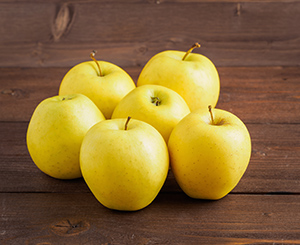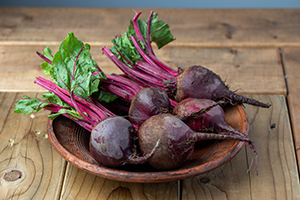Table of Contents

The color of foods depends on their coloring substances, making them appealing and enjoyable.
Artificial coloring—The food industry uses these as additives. They have no positive health effects; unfortunately, many are harmful.
Natural colors—Plant-based foods, mainly fruits and vegetables, contain various colored pigments that enhance their natural beauty. These natural colors are also beneficial to health, and some are even anticarcinogens.

Green
This color results from chlorophyll, the most abundant vegetable pigment. This substance lets plants capture the sun’s energy to synthesize glucose, later converted into starch and other nutrients.
Spinach, lettuce, peas, artichokes, broccoli, legumes, and grain sprouts are good sources of chlorophyll.
Chlorophyll is an antioxidant and blood-purifying. Its anti-cancer properties are under investigation.

Red
Red is from lycopene, a carotenoid (a pigment similar to carotene in carrots). It is a powerful antioxidant. It neutralizes free radicals that damage the DNA in the cells and cause mutations and premature aging. It adds to the proper function of the prostate and prevents it from becoming cancerous.
Lycopene is found mainly in tomatoes, watermelons, peppers, and strawberries.
Orange

This color is due to carotenes, antioxidant, and anticarcinogenic vegetable pigments. Beta-carotene is the most important because it transforms into vitamin A in the body in a much higher proportion than other carotenes or carotenoids (pigments similar to carotenes).
Carotenes are found in carrots, oranges, squash, mangos, apricots, and other yellowish or orange fruits.
Yellow

Various pigments present this color:
Carotenoids, such as lutein, in corn. Carotenoids are antioxidants and serve to protect the retina. Spinach also contains lutein, although they are not yellow since chlorophyll is its predominant pigment.
Flavonoids, such as the quercetin found in apples. Flavonoids are the most common pigments in fruits and have a variety of medicinal properties, particularly anti-inflammatory and antioxidant.

Purple
This color is produced by anthocyanins, antioxidant substances that improve blood circulation in the capillaries and veins. They add to the essential role of the retina and improve vision.
Purple grapes, mulberries, blueberries, and the skin of eggplants are rich in anthocyanins.

Deep Red
This rich color is due to a type of anthocyanin called betacyanin, which has similar properties to purple anthocyanins. They may also act as anti-anemics.
They are found in red beets and pomegranates.
Frequently Asked Questions
Why is it important to eat the right colors?
When you eat the right colors you can significantly impact your health. Different colors in fruits and vegetables signal the presence of various phytonutrients and antioxidants. For example, red foods like tomatoes and strawberries are rich in lycopene, maintaining heart health. According to a study in the Journal of Nutrition, diets high in colorful fruits and vegetables can cut the risk of chronic diseases by up to 30%.
How do different colors of food benefit the body?
Each color offers unique health benefits. Green foods, like spinach and kale, are packed with chlorophyll and fiber, aiding in detoxification and digestion. Blue and purple foods contain anti-inflammatory anthocyanins, such as eggplants and blueberries. Research shows that people who eat the right colors tend to have lower inflammation and oxidative stress rates.
What role do antioxidants play in colorful foods?
Antioxidants in colorful foods protect your cells from damage caused by free radicals. For instance, beta-carotene in orange foods like carrots and sweet potatoes converts to vitamin A, which is essential for vision and immune function. The American Journal of Clinical Nutrition details that diets high in antioxidants from colorful foods are associated with a lessened risk of cancer and cardiovascular diseases.
When you eat the right colors does it improve mental health?
Absolutely. Consuming a variety of colorful foods can enhance mental health. For example, green leafy vegetables are high in folate, which supports brain function and mood regulation. A study from Harvard Health found that people who eat the right colors, particularly greens, experience lower rates of depression and cognitive decline.
How does eating the right colors affect energy levels?
Colorful foods are often rich in vitamins and minerals that boost energy. Citrus fruits like oranges and lemons are crammed with vitamin C, facilitating iron absorption and energy production. According to the Mayo Clinic, individuals who consume a rainbow of fruits and vegetables report higher energy levels and better overall vitality.
Are there specific colors that promote heart health?
Yes, red and purple foods are particularly beneficial for heart health. Red foods like beets and red peppers contain nitrates and antioxidants, enhancing blood flow and reducing blood pressure. The American Heart Association suggests that including these colors in your diet can lower the risk of heart disease by up to 20%.
What is the impact of colorful foods on digestive health?
Eating a variety of colors can enhance digestive health due to their high fiber content. For instance, yellow foods like bananas and corn are rich in soluble fiber, which advocates healthy gut bacteria. A study published in Gut Health revealed that individuals who eat the right colors have a more diverse and balanced gut microbiome.
Can eating colorful foods aid in weight management?
Colorful foods are typically low in calories and nutrients, making them ideal for weight management. Green vegetables, for example, are low in calories but high in volume, helping you feel full longer. The International Journal of Obesity states that diets emphasizing colorful fruits and vegetables can lead to sustainable weight loss and maintenance.
How does eating the right colors affect skin health?
Colorful foods can improve skin health due to their high content of vitamins and antioxidants. Orange foods, such as carrots and pumpkins, are rich in beta-carotene, which is beneficial for healthy skin and reduces signs of aging. A British Journal of Dermatology study found that people who consume various colorful foods have better skin elasticity and fewer wrinkles.
Is eating the right colors possible to get all the necessary nutrients?
While eating the right colors can provide a broad spectrum of nutrients, it’s also important to maintain a balanced diet that includes proteins, fats, and whole grains. Colorful foods complement these other dietary components to ensure comprehensive nutrition. According to Nutrition Today, incorporating various colors into your diet is a straightforward and applicable strategy for achieving optimal health.
DISCLAIMER: All content on this website is presented solely for educational and informational objectives. Do not rely on the information provided as a replacement for advice, diagnosis, or treatment from a qualified medical expert. If you are pregnant, nursing, or have any preexisting medical concerns, talk to your doctor before using any herbal or natural medicines.
REFERENCES
- George D. Pamplona-Roger, M.D. “Encyclopedia of Foods and Their Healing Power.” George D. Pamplona-Roger, M.D. Encyclopedia of Foods and Their Healing Power. Trans. Annette Melgosa. Vol. 2. Chai Wan: Editorial Safeliz, 2005. 394, 395. Print.
- Journal of Nutrition: https://academic.oup.com/jn/article/133/9/2871S/4688302
- Harvard Health: https://www.health.harvard.edu/mind-and-mood/foods-linked-to-better-brainpower
- American Journal of Clinical Nutrition: https://academic.oup.com/ajcn/article/112/4/810/5879433
- Mayo Clinic: https://www.mayoclinic.org/healthy-lifestyle/nutrition-and-healthy-eating/expert-answers/energy-foods/faq-20058478
- American Heart Association: https://www.heart.org/en/news/2020/06/23/eating-a-diet-rich-in-colors-can-boost-heart-health
- Gut Health: https://www.gutmicrobiotaforhealth.com/en/dietary-fibers-impact-gut-microbiota-health
- International Journal of Obesity: https://www.nature.com/articles/s41366-020-0522-5
- British Journal of Dermatology: https://onlinelibrary.wiley.com/doi/10.1111/bjd.19024
- Nutrition Today: https://journals.lww.com/nutritiontodayonline/fulltext/2020/09000/a_colorful_diet__a_key_component_of_nutrition_for.4.aspx
